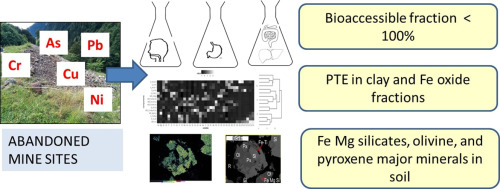Science of the Total Environment ( IF 8.2 ) Pub Date : 2018-10-11 , DOI: 10.1016/j.scitotenv.2018.10.115 Neha Mehta , Tatiana Cocerva , Sabrina Cipullo , Elio Padoan , Giovanna Antonella Dino , Franco Ajmone-Marsan , Siobhan Fiona Cox , Frederic Coulon , Domenico Antonio De Luca

|
Oral bioaccessibility and solid phase distribution of potentially toxic elements (PTE) from extractive waste streams were investigated to assess the potential human health risk posed by abandoned mines. The solid phase distribution along with micro-X-ray fluorescence (micro-XRF) and scanning electron microscopy (SEM) analysis were also performed. The results showed that the total concentrations of PTE were higher in <250 μm size fractions of waste rock and soil samples in comparison to the <2 mm size fractions. Mean value of total concentrations of chromium(Cr), copper (Cu), and nickel (Ni) in waste rocks (size fractions <250 μm) were found to be 1299, 1570, and 4010 mg/kg respectively due to the parent material. However, only 11% of Ni in this sample was orally bioaccessible. Detailed analysis of the oral bioaccessible fraction (BAF, reported as the ratio of highest bioaccessible concentration compared with the total concentration from the 250 μm fraction) across all samples showed that Cr, Cu, and Ni varied from 1 to 6%, 14 to 47%, and 5 to 21%, respectively. The variation can be attributed to the difference in pH, organic matter content and mineralogical composition of the samples. Non-specific sequential extraction showed that the non-mobile forms of PTE were associated with the clay and Fe oxide components of the environmental matrices. The present study demonstrates how oral bioaccessibility, solid phase distribution and mineralogical analysis can provide insights into the distribution, fate and behaviour of PTE in waste streams from abandoned mine sites and inform human health risk posed by such sites .
中文翻译:

将废弃矿场的采掘废物和土壤中潜在的有毒元素的口服生物可利用性与固相分布联系起来:意大利西北部坎佩洛蒙蒂的案例研究
对提取废物流中的口服生物可及性和潜在有毒元素(PTE)的固相分布进行了研究,以评估废弃矿山对人类健康的潜在危害。固相分布以及微X射线荧光(micro-XRF)和扫描电子显微镜(SEM)分析也进行了。结果表明,与<2 mm的颗粒相比,废岩石和土壤样品中<250μm的颗粒中PTE的总浓度更高。由于母体材料,废石(尺寸分数<250μm)中铬(Cr),铜(Cu)和镍(Ni)的总浓度平均值分别为1299、1570和4010 mg / kg。 。但是,该样品中只有11%的镍是口服生物可及的。在所有样品中对口腔生物可及成分的详细分析(BAF,报告为最高生物可及浓度与250μm成分中总浓度之比)显示,Cr,Cu和Ni在1至6%,14至47之间变化%和5至21%。差异可以归因于pH值的差异,样品的有机物含量和矿物组成。非特异性顺序提取表明,PTE的非流动形式与粘土和铁有关。环境基质的氧化物成分。本研究证明了口服生物可及性,固相分布和矿物学分析如何能够洞察废弃矿场废物流中PTE的分布,命运和行为,并告知此类场所造成的人类健康风险。











































 京公网安备 11010802027423号
京公网安备 11010802027423号